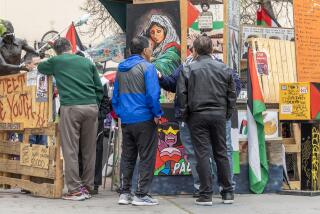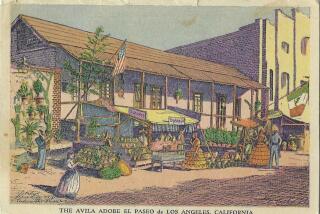History of WWII Gets the Latino Perspective
A dozen World War II veterans, willing to share their distant memories, arrive punctually this spring Saturday morning to be interviewed at the East Los Angeles Veterans Center.
The Purple Hearts and Silver Stars pinned to the chests of the old soldiers, all bearing Spanish surnames, hint at the tales they’ll tell. In small rooms, in front of a video camera, each veteran drifts back to the war, sharing stories of battle, of friendship and, sometimes, of racism.
For the record:
12:00 a.m. June 5, 2002 For The Record
Los Angeles Times Wednesday June 05, 2002 Home Edition Main News Part A Page 2 National Desk 10 inches; 367 words Type of Material: Correction
*
Latino veterans--A story in the May 27 California section incorrectly stated that Mexican Americans have been awarded the Medal of Honor more frequently than any other ethnic group. According to the Congressional Medal of Honor Society, there have been 87 African American and 40 Latino recipients. The story should have said that Mexican Americans have the most recipients within the larger Latino community. Additionally, some others that could be defined as ethnic groups, such as Irish Americans, also have more Medal of Honor awards than Latinos.
As the veterans speak, their stories are captured as part of an oral history project being conducted by the University of Texas at Austin to paint a full sociological portrait of Latino and Latina military personnel before, during and after World War II.
On this morning in East Los Angeles, and in interviews throughout the Southwest, certain themes arise, some common to all soldiers.
Leon Leura--a Duarte combat engineer in the 36th Division--remembered coming face-to-face, bayonet-to-bayonet with a German soldier in Anzio. After a brief struggle, Leura shot him in the forehead. “He was a real young guy. I felt sorry for him.”
Other memories are shared only by other Latino veterans.
Some gravitated toward other Spanish-speaking soldiers overseas. For spiritual support, their parents back home leaned on their Roman Catholic faith. When the soldiers returned, some saw themselves in a new light: They were no longer “Mexicans”--how many men, and society, perceived themselves before the war. Now they saw themselves as “Mexican Americans.”
“When I went into the service, I didn’t have the feelings that I acquired when I was in there--hearing taps, raising the flag,” said Armando Gonzales, 82, of East Los Angeles, who invaded Attu Island as a member of the 7th Infantry Division. “I found myself when I went and served my country faithfully.”
The camera captured other scattered scenes from the old men:
During breaks from battles in Europe, Gilbert Lopez--an Irwindale infantryman in the Army’s 44th Division--picked up a box guitar and began to sing war-themed songs popular among Latino soldiers. The other Latino soldiers joined Lopez, singing in Spanish about the pride of fighting for their patria--country--and the sorrow they felt leaving their lonely mothers back home.
In a foxhole in the Philippines, Jesse Nava, a Lincoln Heights squad leader in the 24th Infantry Division, faced an unthinkable decision: His buddy, arms severed by shrapnel in a 2 a.m. firefight with Japanese troops, asked Nava to have mercy and shoot him.
“That’s always bothered me: Would he have lived?” Nava said. “I went to a rabbi, I went to a Catholic priest, I went to a minister and asked them the same question: Would he have lived?”
The mother of Santos Sandoval, a Montebello platoon leader in the 40th Infantry Division, fulfilling a vow she made to God if he brought her four boys home alive, walked several blocks on her knees to St. Mary’s Church in Fullerton. “That’s how strong her faith was,” Sandoval said, his voice shaking.
Latino World War II veterans have been interviewed before, in small numbers in a handful of regional oral history projects.
But the University of Texas project--started three years ago in the journalism department and led by assistant professor Maggie Rivas-Rodriguez--is the most ambitious in scope.
Rivas-Rodriguez, a small staff and scores of volunteers have interviewed 220 veterans, mostly in the Southwest, though they also want to collect memories from Cubans and Puerto Ricans on the East Coast. The project is branching out beyond soldiers.
“We are trying to get at what was going on with Latinos in society,” said Rivas-Rodriguez. “We have interviewed veterans, women who worked at factories. Now we have some interviews with braceros--Mexican farmhands--who took the place of the [Mexican American] men who left the fields to go to war.”
The project, which aims to establish an archive for researchers, is welcomed in the Latino academic community, where mainstream movies or books about America’s wars prompt new complaints that the story of Latino veterans remains largely excluded.
Tom Brokaw’s widely lauded 1998 book, “The Greatest Generation,” particularly irritated Mario T. Garcia, a UC Santa Barbara Chicano studies professor.
The book, which told the stories of Americans who weathered the Great Depression and World War II, did not include a Latino.
“It’s unconscionable,” said Garcia, “for Brokaw, plus his publisher, to have marginalized the Latino experience in World War II.”
Garcia’s discontent is not new.
Hollywood’s Failure to Portray Latino Heroes
Latino activists often cite the 1960 movie “Hell to Eternity,” based on the acts of Guy Louis Gabaldon. The Marine captured hundreds of enemy soldiers using the Japanese he learned from his Japanese American foster parents in his native East L.A. In the movie, Gabaldon was depicted as an Italian American played by Jeffrey Hunter.
Jesus Salvador Trevino, a television writer and director with directorial credits that include “The Practice,” has complained of Hollywood’s failure to portray Latinos’ heroism in America’s wars.
For years he tried fruitlessly to get funding to tell the story of “Hero Street USA.” The street in Silvis, Ill., was only a few hundred yards in length. Yet, during World War II, 22 Mexican American families sent 65 men to battle.
Indeed, Latinos have fought in every war since the American Revolution, according to the Department of Veterans Affairs.
At the start of World War II, the Latino male population--mostly Mexican American--was about 1 million. Veterans Affairs estimates that up to 500,000 of them, including 53,000 Puerto Ricans, enlisted or were drafted.
Latinos have been awarded the Medal of Honor 40 times--most of them given to Mexican Americans, who have earned the honor more frequently than any other ethnic group, according to Veterans Affairs.
That’s the context to the oral history project.
As the United States was drawn into World War II, many of the Southwest young men and women who joined the military were the children of immigrants who came in search of work or who fled the Mexican Revolution.
In their interviews, some veterans tell of that era’s discrimination against Mexican Americans--particularly segregated schools and swimming pools.
“The Anglos would swim for about a month or so,” said Lopez, 82, recalling Mexican American children’s attempts to use an Azusa pool. “Then, they’d get ready to empty the thing, they put chlorine in the water, and then here we go, nosotros tontones--us, dummies. Imagine that, all that stuff we went through.”
Soldiers traveling between military training facilities in the Southwest commonly encountered signs at restaurants--particularly in Texas--that read: “We don’t serve dogs or Mexicans.”
After being denied a meal, some soldiers, such as Jesus Armendariz of Pico Rivera, a medic in the 88th Infantry Division, quietly walked out.
Not Fred Castro, a La Verne born-and-bred soldier who fought in Europe with the 84th Infantry Division. When he and four other Mexican American soldiers got denied service at a Texas restaurant, they broke everything in the place.
The restaurant owner called the military police, who sided with Castro and his buddies.
“As long as these fellas have the uniform on,” one MP told the owner, “they are white.”
But the war also offered many men, who had seldom ventured out of their rural home towns, a chance to befriend other young men from throughout the country.
“I never experienced any racism,” said Leura, who was taken prisoner by the Germans in France. “I used to hang around with the Italian guys from New York. They got to be buddies with me.”
The war offered many Mexican Americans, as well as other ethnic minorities, a chance to prove their patriotism.
In East Los Angeles, families prided themselves in sending overseas “not one--the whole bundle” of sons, remembered Jose Zaragoza, 81, who joined the Coast Guard and operated electronic equipment in the South Pacific that guided American ships and planes.
For others, such as Armendariz, overseas service gave them memories they treasure.
During a break from action in Italy, he and a buddy strolled through Rome to St. Peter’s Basilica, hoping to glimpse Pope Pius XII. The pope, to their delight, met with several soldiers. Armendariz brought a Sacred Heart, which the pope blessed--and Armendariz brought it home to his mother.
“It was something out of this world,” Armendariz said. “He said, ‘Be with God, my son.’”
The importance of religion--particularly Catholicism--has been a consistent theme in the veterans’ stories, as has the bonding influence of Spanish.
The soldiers had never felt more American and yet, reflecting their dual heritage, worked to keep up their Spanish, afraid to lose their ability to communicate with their parents if they made it back.
As they returned home from war, they also came ready to demand rights that had been denied to them as children in their own country, said author Henry A.J. Ramos, who has written about World War II and Mexican American civil rights.
Of the many organizations that formed after the war, the one that perhaps best exemplifies veterans’ involvement in civil rights, is the GI Forum.
Group Helped Veterans Get Their Benefits
It was founded in 1948 in Corpus Christi, Texas, by Dr. Hector Garcia--who with other veterans initially fought to make sure Mexican American vets received GI Bill benefits.
The GI Forum’s legal victories include helping desegregate schools throughout the Southwest. But no event captures the group’s quest for justice better than the one that launched its founding:
That year, the body of Pvt. Felix Longoria--who was killed three years earlier in the Philippines--arrived in Three Rivers, Texas.
The local funeral chapel refused to bury him. His widow said the funeral director told her the town’s white residents would not like Mexican Americans using it.
The forum’s leadership appealed to then-Texas Sen. Lyndon Johnson, who, outraged, helped arrange a hero’s burial at Arlington National Cemetery.
Making sure such incidents are not forgotten is what drives Rivas-Rodriguez’s project.
After their two-hour interviews, the soldiers--appreciative of the project’s interest in their tales--basked in the rare attention.
“It’s good they’re interviewing us because we’re old,” said Nava. “When we die, the history is going to go with us.”
More to Read
Sign up for Essential California
The most important California stories and recommendations in your inbox every morning.
You may occasionally receive promotional content from the Los Angeles Times.










